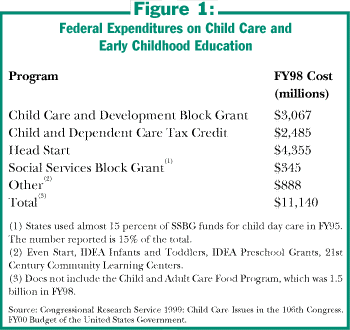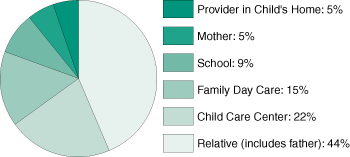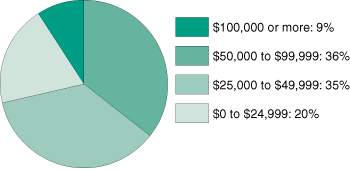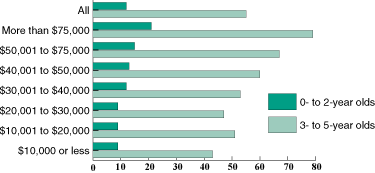Projected government budget surpluses of $2.6 trillion over the next decade are guaranteed to renew the debate over the best use of federal funds. We should use a portion of these funds to provide quality child care and preschool education to low-income children, including those whose mothers now must work because of welfare reform. This can be accomplished by reorienting child-care subsidies and tax credits toward low-income working families and by investing more in high-quality preschool programs for their children. A carefully executed program that provided one or two years of early education to children in families earning modest incomes would pay for itself by improving children’s future opportunities. Such assistance would simultaneously reduce hardship for the so-called working poor.
For the second consecutive year, the president has proposed a major increase in funding for child care and early childhood education. The 1998 proposal foundered when Congress failed to approve tobacco taxes designated to pay for it. But the more than fifty bills introduced in the 105th Congress demonstrate widespread support for publicly financed child care. The debate mainly has centered on the federal government’s role in funding care, the quality of care, and the income targeting of assistance. Policymakers also question whether stay-at-home and working mothers should receive the same benefits. Clinton has proposed a child-care tax credit to provide additional assistance to nonworking parents with children less than a year old.
Three major federal programs fund child care and early childhood education (Figure 1). The Child Care and Development Block Grant provides money to states to subsidize child-care expenses for families with working parents earning less than 85% of the state median. The Child and Dependent Care Tax Credit is a nonrefundable credit for expenses for the care of a dependent child less than thirteen years old. Head Start provides early childhood education and development services to low-income preschool children. The federal government spent approximately $11 billion in FY98 on these and other, smaller programs.
Current budget caps severely constrain any new initiatives in this area, but in the coming decade, child care and early education are likely to vie for resources with other federal spending priorities. Funding these programs for preschool children potentially enhances school performance and future productivity, promotes work and self-sufficiency among those once dependent on welfare, and boosts the net incomes of the poor. The challenge is to design and implement programs that can achieve these objectives.

Government vs. the Family
Many question the role government should play, if any, in the early education and care of children. More than two decades ago, President Nixon labeled federally funded child care a communal approach to child rearing inconsistent with a more family-centered approach. But times have changed. Sixty-two percent of mothers with preschool age children are now in the labor force, compared to 37% in 1975. Growing numbers of single-parent families also strengthen the need for subsidized care. Finally, the welfare reform bill of 1996 requires most low-income mothers to work and seek at least custodial care for their children.
Although its constituency has grown enormously, publicly financed child care should be viewed through another lens—its effect on the well-being of children. Almost no one disputes the importance of a good education at public expense for children beginning when they are five or six years old, but it is commonly assumed that younger children are better off at home. This assumption needs to be questioned. A study sponsored by the National Institute of Child Health and Development (NICHD) has followed 1,364 healthy children since their birth in 1991, and has found no evidence that out-of-home care is either more harmful or more beneficial to children than is parental care.
Despite this evidence, many believe the wholesale movement of mothers into the workforce will inevitably hurt children, and that society should not encourage this trend. Because stay-at-home mothers pay a heavy price in lost income for their decision, many people favor providing the same assistance to nonworking and employed mothers. But the tax code already favors such stay-at-home mothers. Two families with identical incomes pay the same taxes no matter how many people work and no matter what work-related expenses they incur. In addition, nonworking parents with sufficient tax liabilities can receive a $500-a-year tax credit for each child. If further tax credits are provided to stay-at-home mothers, they should be structured to benefit those with family incomes so low that they owe no taxes. It is hard to argue that only better-off mothers should be encouraged to stay home.
Availability, Affordability, and Quality
Working parents use centers, relatives, family day-care centers, and babysitters as custodians for their children (Figure 2). Debate has centered on the availability, affordability, and quality of such care. In recent decades, the supply of paid care has expanded rapidly in response to the need, with only limited increases in price. Access to care presents challenges mainly to parents with infants or nonstandard working hours.

Child care costs each household an average of $4,000 a year. These costs can be prohibitive for low-income families–many spend one-quarter or more of their incomes on child care, and others are forced to use unpaid care of dubious quality. Government child-care subsidies have grown rapidly in recent years, but most child care and preschool education remains privately funded. A 1997 government estimate puts the proportion of eligible low-income children receiving federal subsidies at roughly 10 percent, although this proportion may be higher now due to increased federal and state child-care spending resulting from welfare reform. Because many states give preference to mothers moving off welfare, low-income working families with no ties to the welfare system are the least likely to receive assistance.
Quality is harder to evaluate than costs or availability. Many child-development experts believe the quality of child care influences sociability, cooperation, self-control, and language development. The NICHD study of children through age three suggested that variations in quality have small effects on children. Home environment was much more important. Moreover, the effects of care did not vary with the type chosen (for example, center care vs. care in a neighbor’s home), the age children entered care, or the amount of time in care. These findings were based on careful observations and measurements of the quality and quantity of child care. Independent observers who did not know whether the child received out-of-home care assessed children’s social competencies and behaviors.
Regardless of the role quality child care plays in development, no one wants children to be placed in harmful environments. A number of studies have found that a distressingly high proportion of centers lack characteristics associated with good outcomes, such as small groupings of children and high ratios of adults-to-children. A smaller number of child-care providers fail to meet even minimal safety and health standards.
Should Subsidies be Targeted?
To help families pay for better care, the federal child-care block grant targets families with incomes below 85 percent of a state’s median. As more middle-class and upper-middle-class women have entered the workforce, however, a political constituency has developed for broader-based subsidies in the form of tax credits. The cost of these credits has grown fivefold since the mid-1970s. The Child and Dependent Care Tax Credit (CDCTC) provides as much as $1,400 per year to a family with two children, regardless of income. Forty-five percent of the CDCTC goes to families with adjusted gross incomes of more than $50,000 (Figure 3). Because the credit is not refundable, it provides no benefit to those who earn too little to take advantage of it–less than about $25,000 a year for a family of four.

The case for targeting any new child-care subsidies to low-income families is strong. Single-parent families, for whom employment is a necessity, not a choice, head many poor households. Welfare rules introduced in 1996 require most mothers to work. Child-care subsidies are an indirect way of making work pay. If used as an opportunity to educate children as well, subsidies can be a good investment. New assistance could be financed, in part, by taking the politically difficult step of limiting eligibility for the existing $2.5 billion child-care tax credit to families with modest incomes–say, less than $60,000 a year. The savings of about $1 billion could then be used to offset the costs of providing more help to low-income children.
Targeting child-care subsidies on low-income families has considerable merit, but it also makes sense to extend access to all for a sliding-scale fee. A flexible payment plan would reduce the disincentive associated with earning more income and promote a greater mixing of children from different economic backgrounds.
The Growing Commitment to Early Education
Concerns about the quality of care merge with the question of when formal education should begin. The line between child care and early childhood education is ill-defined. No basis exists for thinking that education should begin at age five or six rather than at age three or even younger. Parents who must work need a safe place to keep their children; everyone benefits if the children are also educated.
Research showing that children’s brains develop extremely rapidly before age three strengthens the view that even very young children need education, not just custodial care. Early educational experiences–such as being talked to or read to–are important to a child’s development and later preparation for school. Some children receive appropriate stimulation and education at home, but others enter school with deficits that are extremely difficult to reverse at a later age. Higher quality, more education-oriented care for very young children, targeted to the most disadvantaged, could help reduce such disparities.
High-quality programs have produced short-term gains in cognitive functioning and longer-term gains in school achievement and social adjustment, according to research. Recent reviews of this literature by the Rand Corporation, by Steven Barnett at Rutgers University, and by a team of researchers at the University of Wisconsin, conclude that early interventions, especially with disadvantaged children, have produced a variety of positive results as children mature. They experience improved school achievement, lower grade retention, fewer special education courses, and reduced crime. Barnett, for example, reviews fifteen model and twenty-three large-scale public programs that enrolled disadvantaged children before they turned five. The researchers examined at least one measure of school achievement or socialization through age eight for both the children enrolled in the program and a control group. The best results came from those interventions that began early, included children from the most disadvantaged homes, and provided intensive education and other services over a lengthy period. In the most successful programs, social benefits that could be monetized greatly exceeded program costs, with net savings to the government of from $13,000 to $19,000 per child, according to the RAND study.
Critics of this literature assert that the gains fade as children age, that the studies are flawed, and that model programs are difficult to take to scale. These critics tend to focus on IQ and ignore the longer-term improvements in school performance found by many studies. However, they correctly gauge the difficulties of expanding programs to scale. Head Start, for example, has borne its share of management and staffing problems, leading Congress and the Clinton administration to earmark an increasing proportion of the funds for quality improvements including higher-paid and better-trained staff. The Head Start experience illustrates the need to expand programs carefully and to avoid replacing strong programs with less expensive ones in an attempt to serve more children.
The importance of early education is increasingly recognized in states where public funding of preschool programs is catching on, albeit at an uneven pace. Other countries also recognize the need to provide children with an educational experience from an early age. In France and Italy, for example, nearly all children three to five years old are enrolled in publicly funded preschools. But perhaps parents themselves provide the most telling indicator of the importance of early education. Families are enrolling their children in preschool programs in record numbers (Figure 4). In fact, the proportion of children from affluent families enrolled in preschool is twice that of those from families with more limited incomes. The children who most need a head start are not always getting it.

Toward a New Federal Commitment to Early Education
Individual families and some states will undoubtedly continue to make investments in young children, and some will argue that a federal role is unnecessary or even counterproductive. There is considerable sentiment in this country for keeping education, including preschool education, as a state and local responsibility. But only the federal government can ensure that all children have equal access to a good education, regardless of where they live. Providing medical care and retirement benefits to the elderly and welfare benefits and food stamps to the poor are time-honored federal commitments. But these programs essentially pick up the pieces after the education system has failed. Any state or community that neglects its children’s education imposes large costs on everyone else. A federal commitment to fund more early childhood education would only partially compensate for existing disparities in state education spending, but it would be a move in the right direction.
The Head Start program could be expanded gradually, with careful attention to quality. Head Start serves about 40 percent of eligible children, most of them four year olds, in a nine-month, part-day program that costs about $5,000 per child. More full-day, full-year slots should be provided to meet the needs of working parents. Each child should be enrolled for a longer period, starting when they are infants or toddlers. Although the Early Head Start program currently serves some children under three, it is still very small, enrolling less than 2% of all preschool children from poor families.
Alternatively, a generous tax credit or voucher to be used only in accredited preschool facilities could be provided to low-income families. Standards could be established by states or by the federal government with the advice of professional groups. A tax credit would combine the federal support for education that liberals favor with the school-choice and provider-competition components that many conservatives endorse. The program design should ensure that new funds would not simply supplant existing state resources. It should also include direct support for local institution building and teacher training and certification. A nonprofit group in New York City has launched a new initiative called Satellite Child Care, for example, which supplies training to in-home providers who are given salaries well above average earnings in this low-paying sector. They also receive a computer linked to a supervising daycare center and a variety of professional supports.
Providing preschool to every poor child would be costly. A high-quality, two-year program costing about $8,000 annually per child would total some $30 billion per year if limited to families with incomes of less than $30,000. An equally expensive, high-quality one-year program, limited only to the children of the poor, would cost about $3 billion more than the $4.3 billion the federal government now spends on Head Start. Politics will always argue for serving more children at a lower cost per child. But in the end, the politically satisfying strategy is likely to be self-defeating because inexpensive programs are usually ineffective as well. With limited resources, it is better to provide fewer children a quality program that promises to improve their prospects.
Recent budget debates have emphasized the importance of using projected surpluses to pay down the debt, thereby freeing up funds for private investment. But an investment in people drives the future economy as much as does our savings and investment in tangible capital. If we want to prepare for the retirement of the baby-boom generation, we must not only save more both individually and collectively–but also invest more in those who will pay the costs of that retirement: the children.
The Brookings Institution is committed to quality, independence, and impact.
We are supported by a diverse array of funders. In line with our values and policies, each Brookings publication represents the sole views of its author(s).



